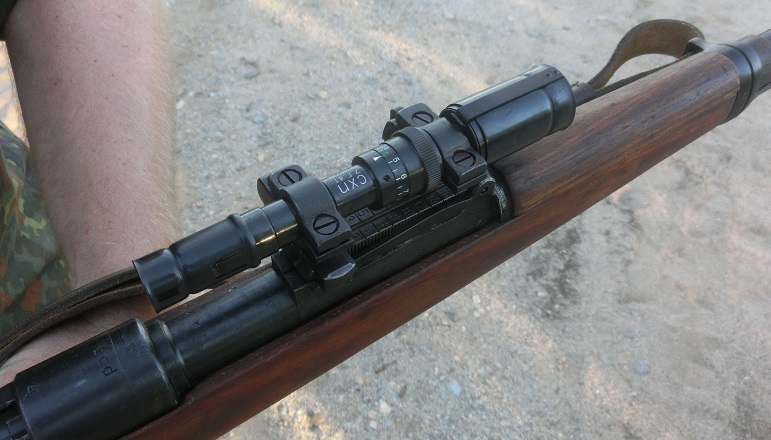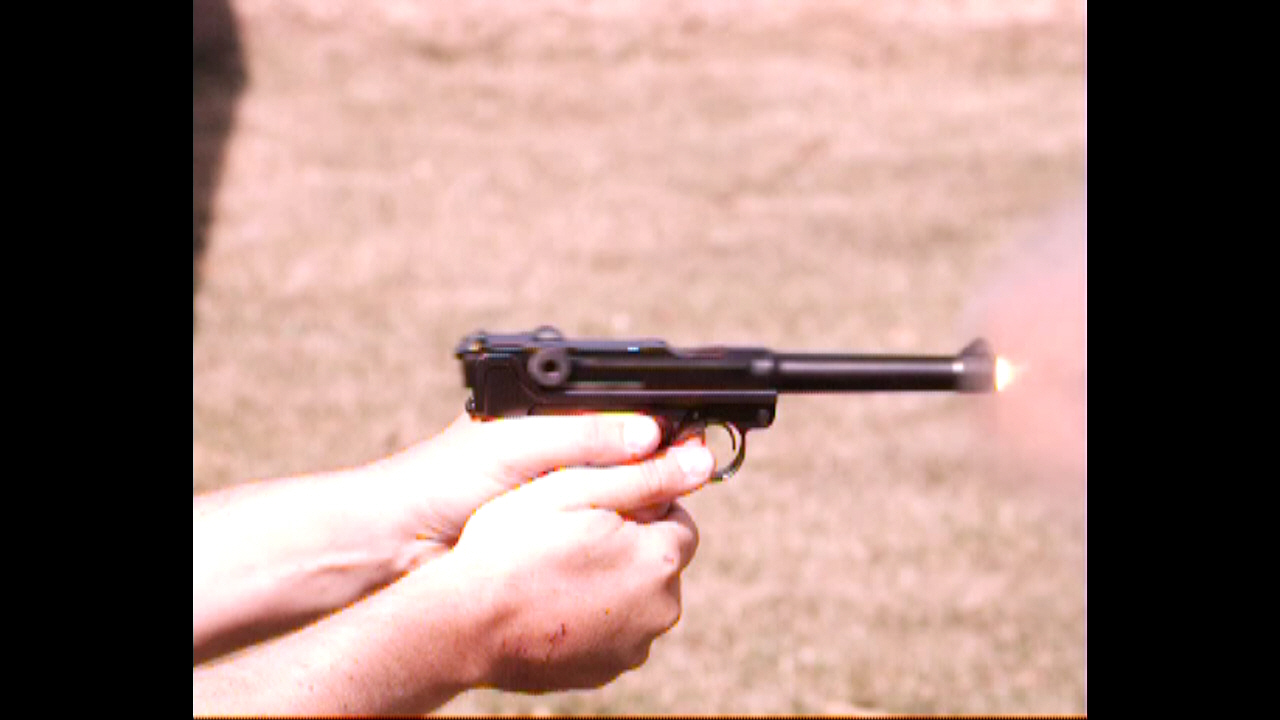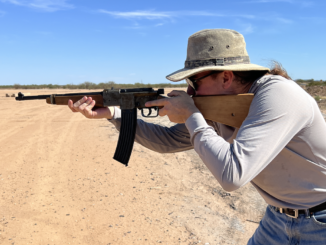The ZF-41 was a tiny 1.5x optic made in large numbers by Germany during WWII. It is a long eye relief design, mounting over the rear sight of a K98k, and allowing unimpeded up for stripper clips for reloading. These scopes are generally though to have been complete failures, and a huge disappointment to German snipers. Well, they were disappointing to snipers – but that is because they were never intended to be used by snipers. The ZF-41 was an early example of a designated marksman’s optic – something to allow the best shot in a squad to get that little extra capability to make tricky shots. It was put into service with snipers because it was available in much greater numbers than proper 4x sniper scopes, and couple be easily added to a rifle in the field.
Karl and I took a reproduction ZF-41 and K98k, and put it through some timed tests to see just how useful or useless it really was – and we were very happily impressed at the results! The video is available this morning over at Full30.com.
The scope and mount were purchased from Numrich, where they are still available.





I’ve always suspected that the Zf-4/Kar98k combination strongly influenced Jeff Cooper’s Scout Rifle concept.
A Zf-4 mounted on a 6.5 x 55mm Swedish Mauser artillery carbine, or on a 6.5 x 53mm or .308 Winchester Mannlicher-Schoenaur 1954 sporter carbine, would be highly interesting.
cheers
eon
Cooper usually went out of his way to give credit for the various advances he championed. For the forward-mounted scope he gave no one credit, including himself. That suggests it was not a completely alien concept when he first adopted it (i.e., forward mounts were already known by gun enthusiasts so as to need no introduction), or maybe it was difficult to pin down who first used them.
What he liked about it, I think, was not so much the accuracy but the speed it allowed, especially in snap shots at targets of opportunity. Also, he was well into middle age when he really took up the concept and having only to focus on one plane surely helped as one’s eyes aged.
I once mounted a Bushnell 1.5-5X variable on top of the action of a Marlin 1895 .45-70. I found that with the scope dialed down to 1.5, I could keep both eyes open, bring it from ready carry to firing stance, and the crosshair was clearly visible as a sort of “ghost ring”, much like the old Aimpoint sight. And it consistently “shot to center”.
Here in OH, I never really did work out a practical use for the combination. But in Alaska, for example, a .457 Guide Gun set up like that might be useful in event of a brownie contesting your existence out in the back country.
cheers
eon
Hello i have a ZF41 scope for my Mauser BYF42 rifle. The lens who support the reticule has a problem. Maybe do you know where can i buy it?
Thank you
Reason Yugo M75 ammo is so similar to German WW2 sniper loading is that scoped Kar98s were most commmon sniper and marksman rifles in YPA. M48 snipers were actually relatively rare until early ’60s and were never that common. Until introduction of M76 most scoped rifles were Kar98 and Mosins, 2nd one being unpopular due the non-standard caliber but still used due the lack of enough scoped M48/Kar98.
Anyway ZF-41 equipped rifles were issued one per platoon in infantry and mountain units (+ one scoped rifle with higher magnification scope at company level), and two per platoon among paratroopers. They served until replaced by M76… When replaced ZF-41 equipped rifles were popular for hunting around here, my uncle had one back in ’80s.
There was also very rare Zrak made copy of ZF-41 scope.
Thanks, Bojan – that’s great info!
Addition, Kar98s were still in 1985 list of infantry armament. It lists following sniper rifles (note that there is no sniper version of M48 in list):
Rifle, sniper M98/48(n)
Rifle, sniper M91/30(s)
Rifle, sniper M69
Semi-auto rifle, sniper SVT-42 – scoped SVT-40
Semi-auto rifle, sniper Mauser M43 – scoped G-43
Semi-auto rifle, sniper M76
Semi-auto rifle, sniper G3 SG/1(n)
Full list here, with explanations and other stuff. It has quite a bit of exotics including G41M and AVT-40…
http://www.tank-net.com/forums/index.php?showtopic=36258&page=1
Just for comparison, the closest current modern equivalent scopes might be the Burris “Scout” model (http://www.burrisoptics.com/scout2x7x.html) and the Leupold FX-II Scout (http://www.leupold.com/hunting-shooting/scopes/fixed-power-riflescopes/fx-ii-scout-ier-2-5x28mm/) among others.
These are all higher magnification (2.5 or 2.75 fixed, with the Burris also having a model that is adjustable from 2x-7x) with eye relief ranging from 7″ to 12″ depending on model. (The fixed magnification models having 7″-9″ eye relief.)
I think the ZF-41 had longer eye relief, perhaps over 12″ ?
FWIW, I have a 2-7x Burris long eye relief scope on an M1. It provides a much bigger viewing lens, much more light gathering capability, and is generally much more scope than the FZ41 in every way. Including, of course, weight. The FZ41 has a very minimal impact on the handling of a K98k, while a modern scout scope and mount have much more effect on weight and balance.
Please advertise full30.com more. I just learned about it a week ago. The first thing I saw was your excellent video on the “observation” cartridges.
i would have to agree with the snipers. a 1.5 mag on a 8mm mauser just doesnt make sense.
Military sniper scopes of that era weren’t very powerful in most cases. The U.S. M81 (M1C) and M82 (M1D) sniper scopes were milspec versions of the Lyman Alaskan, both 2.5X.
By Korea, they had been superseded by the Stith-Kollmorgen scope, a milspec Stith Bear Cub, 2.2x.
The British No.32 scope, used on the Rifle No. 4(T), was a 3.5x.
The actual “dedicated” German sniper scope for the Kar98, the Zf39, was a 4x. In fact, its common nickname, “Zielvier”, means “four power” in German. It was commonly called by its number or that name because Zf39s were made by several different firms, Mauser, Hensoldt, Kahles, Voightlander, etc.
Some SS snipers apparently used commercial sporting rifles with more powerful scopes such as Unertl 10x. These may have been personally-owned weapons, ones “impressed” from manufacturer inventories at the beginning of the war, or ones confiscated in the occupied countries. See Guns of the Third Reich by John Walter; The Master Sniper (novel) by Stephen Hunter.
Such arrangements were common in the Balkans war in the 1990s, as well. But practically every small arm made in Europe since about 1900 turned up there, I believe.
Keep in mind that military sniping is less about precision as it is about “reach”. The main mission is to destroy enemy morale. By killing men at distances which they otherwise believe is safely “out of range”.
It isn’t as important to hit a specific person in a group at 900 meters as it is to just hit somebody. It tends to shake up the rest. To say nothing of their response to hearing rifle bullets winging past their ears.
A 2.5x scope brings 900 meters down to an “eyeballed” range of 360 meters. Close enough to hit a man in the chest with average “iron sight” accuracy.
Which is good enough for the purpose.
cheers
eon
Many people may not realize that telescopic rifle sights, “scopes”, are optically quite difficult to design, since they need to have sufficient eye-relief. A good field-of-view is very desirable as well, further complicating the design. Telescopes with very little eye-relief and narrow field-of-view are much easier to design. Many of the technologies that make modern excellent rifle scopes possible were simply not available during WW2 or their cost was prohibitive.
@eon
Well, actually ‘Zielvier’ is an abbreviation from ‘Zielfernrohr mit vierfach Vergroesserung’, or a Sighting Telescope with Four-power Magnification, so a literal translation of the Zielvier would be something like “Scopefour”, and not just ‘4-power’. And it was really not a nickname, but a pre-war commercial name of a series of Zeiss scopes: other than Zielvier (4x) there was also a Zielsechs (6x).
@Ian
You sure it was T-34s this German sniper was hunting with his scoped rifle? Well, actually I’m not, because you’d need the driver to open his big entry hatch to give any shooter an unobstructed view of himself in a T-34 (and that’s a completely unreal occurance in tactical conditions, unless he had a death wish, won’t you agree?) – there were NO sighting slits or ports at the driver’s position in this tank, just armor-glass episcopes, designed to prevent just precisely such a driver casualty. Perhaps he meant T-26 (Soviet copy of the Vickers E 6-Ton) or a BT (Soviet copy of Christie tank)? Conversely, in Soviet memoirs, every German tank is either a Tiger or a Ferdinand, even in 1941, when nobody even dreamed of these two.
@Leszek
Unless the incident happened in 1941 or early 1942, it is unlikely that the tanks were T-26s or BTs (yes, I know, some BT tanks survived until 1945 in Asia to fight the Japanese in Manchuria). More likely candidates would be T-60 and T-70 light tanks, which the Soviets manufactured in large numbers and used for infantry support where medium tanks were not available. Both the T-60 and the original T-70 have a direct driver’s vision slit, which could be shot through with a rifle. Late production T-70 has a periscope for the driver instead, indicating that the Soviets had realized the problem. The T-70 could be mixed up with a T-34 in a hurry. Wikipedia has a nice image of a T-70 from Togliatti (mid-production I believe, but stand to be corrected):
http://en.wikipedia.org/wiki/T-70#mediaviewer/File:T-70,_technical_museum,_Togliatti-1.jpg
It’s a big improvement on the iron sights…
Has anyone out there ever tried to zero in one of these scopes with the two pins as per manual?
John,
That’s discussed in the video, I believe… I zeroed it using the two pins as you described.
It’s a challenging process if the gun isn’t locked into a vice, with or without the helpful prismatic zeroing device.
Some of the shots would probably have hit a man sized target in the open anyway, but you could see it was worth the effort zeroing it to show it’s effectiveness against targets more representative of men in cover which is were they usually shoot at you from.
Ian,
This is not really a comment.
While reading one of the exchanges I understood that there are also other forms of your presence on-line, and that you are remunerated for every entry of the gun enthusiasts on one (every one?) of them. Once you said on this page, that you are not allowed to speak about financial aspects?/advertising?.
I tried my luck on other pages through Google.
However, as a member of “analog generation” I must have done something incorrectly with my log-in (I avoid any activities, like for instance giving recommendations, which involve logging-in for this reason).
If you can give me the answer on this page, please do. If this is not feasible, then I will try my luck again.
Regards, Andrzej
I had read somewhere (old Shotgun News ad for same?) that the reproduction ZF-41 were actually 2.5x rather than the original 1.5x. Is that possible? If so, do you think it was done to market them closer to an established American standard for a scout rifle? I have a Steyr AUG/SA and I think a 1.5x optic is actually pretty good in that application, although maybe not in the vogue nowadays. I agree that it must be an appreciable shooting aid on a KAR-98k and will probably have to get one for mine. To further confuse things, the SARCO/NUMRICH ad nowadays reads “2×5 power scope”. I’m almost certain however that the old Shotgun News ad (when they first came out) stated that they were 2.5x magnification. Again, that might not be a bad thing, I just wish that they would do a better job of stating the specs of the repro ZF-41 (to include objective size), and also where and by whom it is made. I still want one, in any case. Anyway, I enjoyed the video.
Andy